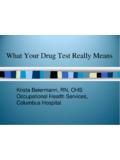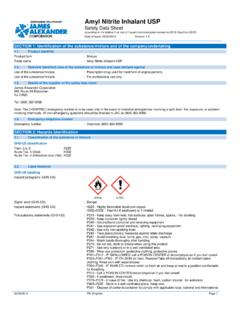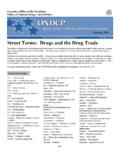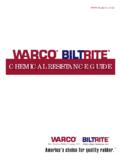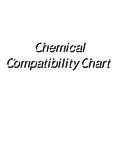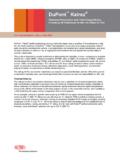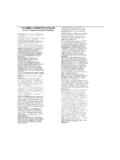Transcription of EMERGENCY ANTIDOTAL MANAGEMENT OF …
1 EMERGENCY ANTIDOTAL MANAGEMENT OF POISONINGS. Nebraska Regional Poison Center: 1-800-222-1222. EMERGENCY ANTIDOTAL . This educational poster is not intended for individual patient care. Information is believed accurate as of 2/2011. If you are caring EMERGENCY ANTIDOTAL MANAGEMENT OF POISONINGS. for a known or suspected toxic exposure patient, please call your regional poison center for patient-specific MANAGEMENT advice. Poison MANAGEMENT . Nebraska Regional Poison Center: 1-800-222-1222. Antidote OF POISONINGS Stocking Level Dose Comments This educational poster Acetaminophen is not N-acetylcysteine (NAC;intended Mucomyst ) for 54. individual patient g* [30 mL 20% sol. vials x 9] care. Information Loading Dose:is140believed accurate mg/kg PO; Maintenance Dose:as of 2/2011. 70 mg/kg q 4 hr PO. MayIf you Mostare caring effective if initiated within 8 hours of acute ingestion.
2 May be of value even in late presenters. Typically continued for 36 h require antiemetic for first few doses. or longer, depending on clinical situation. Contact PC for case-specific dosing recommendations. for a known or suspected toxic exposure Acetylcysteine for IV use (Acetadote ) patient, please call 30 g [10 mL vials (100 Nebraska your mg/mL) x 30] regional poison Regional 150 center for mg/kg over 1 hr, then patient-specific mg/kg for 4 hr, then Center: MANAGEMENT Preferred if advice. 1-800-222-1222. mg/kg/hr for 16 hr or persistent vomiting, unable to protect airway, hepatic failure, or pregnancy. Should be continued beyond 21 h if until APAP < 10 and liver enzymes normal or improving acetaminaphen level remains elevated or worsening liver injury. Call PC for case-specific advice. This educational poster is not intended for individual patient care.
3 Information is believed accurate as of 2/2011. If you are caring for a known or suspected toxic Anticholinergics Physostigmine (Antilirium ) 4 mg* [2 mL vials (1 mg/mL) x 2] 1-2 mg IV (adult); mg/kg IV (child) diluted in 10 cc NS over 5 min Physostigmine may cause seizures or life-threatening arrhythmias (if used in setting of tricyclic antidepressant overdose with exposure patient, please call your regional poison center for patient-specific MANAGEMENT advice. QRS widening or bradycardia). Contact PC for guidance. Benzodiazepines Flumazenil (Romazicon ) NOT 4 mg [1 mg/vial x 4] Adult: mg IV to total dose max 3 mg; Child: mg/kg IV to total dose max Contraindicated in benzodiazepine-dependent patients, poly-drug overdoses and unknown ingestions due to risk of seizures. 3 mg FOR IATROGENIC OVERDOSE ONLY Can almost always manage benzodiazepine exposure with supportive care.
4 Poison Antidote FOR OVERDOSE. RECOMMENDED Stocking Level Dose Comments PATIENTS. Acetaminophen N-acetylcysteine (NAC; Mucomyst ) 54 g* [30 mL 20% sol. vials x 9] Loading Dose: 140 mg/kg PO; Maintenance Dose: 70 mg/kg q 4 hr PO. May Most effective if initiated within 8 hours of acute ingestion. May be of value even in late presenters. Typically continued for 36 h Beta Blockers Glucagon 90 mg* [1 mg/vial x 90] 50-150 mcg/kg IV bolus, then 50 to 100 mcg/kg/hr infusion Continuous ECG monitoring. May cause nausea/vomiting. Phenol diluent should not be used for preparing infusion. require antiemetic for first few doses. or longer, depending on clinical situation. Contact PC for case-specific dosing recommendations. Calcium Channel Blockers 1) Calcium gluconate and/or Calcium Calcium 200 mEq* [CaCl mEq/10ml x 20; Dose varies by agent/context Ca chloride 10% recommended for administration by central venous catheter.]
5 Ca gluconate can be given through a peripheral Acetylcysteine for IV use (Acetadote ) 30 g [10 mL vials (100 mg/mL) x 30] 150 mg/kg over 1 hr, then mg/kg for 4 hr, then mg/kg/hr for 16 hr or Preferred if persistent vomiting, unable to protect airway, hepatic failure, or pregnancy. Should be continued beyond 21 h if chloride CaGlu mEq/10mL x 40] vein. until APAP < 10 and liver enzymes normal or improving acetaminaphen level remains elevated or worsening liver injury. Call PC for case-specific advice. Anticholinergics 2) High dose insulin/glucose Physostigmine (Antilirium ) Regular 4 mg* [2 Insulin mL vials3500 Units **x 2]. (1 mg/mL) Bolus 1-2 mg1 IVU/kg regular (adult); mg/kg+ IV. 25-50 g dextrose (child) diluted in(adult);. 10 cc NSInfuse 5 minU/kg/hr Give in ICU setting;. Physostigmine may monitor cause seizures may be life-threatening delayed 30-60.
6 Arrhythmias Has (if used alsoofbeen setting used tricyclic in beta blockeroverdose antidepressant toxicity. with insulin and dextrose to maintain euglycemia QRS widening or bradycardia). Contact PC for guidance. Benzodiazepines 3) Glucagon(Romazicon ) NOT. Flumazenil 90. 4 mgmg*[1 [1mg/vial mg/vialx 4]x 90] 50-150 mcg/kg Adult: mg IVIV tobolus, then max total dose 50-100 mcg/kg/hr 3 mg; IV titrated Child: mg/kg toIVeffect to total dose max Glucagon as adjunctive Contraindicated tx of hypotension/bradycardia. in benzodiazepine-dependent patients,Phenol diluent poly-drug should and overdoses not be used foringestions unknown to risk of seizures. Carbon Monoxide Oxygen ** 1) 100% Oxygen 2) Hyperbaric 3 mg FOR IATROGENIC OVERDOSE ONLY Oxygen Call Can PC for indications almost for using always manage hyperbaric oxygen.
7 Benzodiazepine exposure with supportive care. RECOMMENDED FOR OVERDOSE. Cholinesterase Inhibitors 1) Atropine 1) 20 mg* [20 mL vials ( mg/mL) x 3; Initial dose for Adult: 2 mg IV; Child: mg/kg IV. Repeat q 5 min until Atropine given until cessation of excessive oral and pulmonary secretions. Stockpiles of atropine and pralidoxime IV vials and PATIENTS. OR 1 mL vials ( mg/mL) x 50; reversalmcg/kg of bronchospasm and50excessive secretions. auto-injectorsECG. (Mark I Kits andMay DuoDotes) are available in allPhenol Contact PC for (Organophosphates;. Beta Blockers Glucagon 90 mg* [1 mg/vial x 90] 50-150 IV bolus, then to 100 mcg/kg/hr infusion Continuous monitoring. cause nausea/vomiting. should notaccess be usedinformation. for preparing infusion. Carbamates; Nerve Agents) OR 10 mL vials ( mg/mL) x 20]. Calcium Channel Blockers 1) Calcium gluconate and/or Calcium Calcium 200 mEq* [CaCl mEq/10ml x 20; Dose varies by agent/context Ca chloride 10% recommended for administration by central venous catheter.]
8 Ca gluconate can be given through a peripheral chloride CaGlu mEq/10mL x 40] vein. 2) High 2) Pralidoxime (2-PAM, Protopam ). dose insulin/glucose 2) 12 g*Insulin Regular [10 mL3500. vials Units 100 mg/mL. ** x 12] Initial bolus 30 mg/kg IV, up to 2 g over 30-60 min. Maintenance infusion of 8- Pralidoxime Bolus 1 U/kg regular insulin + 25-50 g dextrose (adult); Infuse U/kg/hr Give in ICU setting; may be monitor given over 2 min for glucose. life-threatening Response may be nicotinic delayed effects. Indicated 30-60 min. in organophosphate Has also been used in betapoisoning. Efficacy in blocker toxicity. 10 mg/kg/h insulin (up to 650tomg/h). and dextrose maintain euglycemia carbamate toxicity is controversial. Contraindicated in carbaryl (Sevin ) exposure. Cyanide 1). 3) Hydroxocobalamin Glucagon (Cyanokit ) 10.
9 90 g*mg*(2[1kits). mg/vial x 90] Adult: 50-1505mcg/kg g; Child:IV70bolus, mg/kgthen IV over 50-100 15-30 min IV titrated to effect mcg/kg/hr Preferred Glucagon treatment as adjunctive(especially for cyanide poisoning due tx of hypotension/bradycardia. to smoke Phenol diluentinhalation). should notCan be repeated be used as clinically necessary. Na for infusions. Carbon Monoxide Oxygen ** 1) 100% Oxygen 2) Hyperbaric Oxygen thiosulfate can be co-administered through Call PC for indications for using hyperbaric oxygen. a separate IV line. 2) Cyanide Antidote Kit (Amyl nitrite, 2 kits = 2 amyl nitrite ampules, 600 mg Na nitrite, 1) Amyl nitrite perles: Inhalation for 30 secs of each min; 2) Na nitrite, Adult: 10 Amyl nitrite given with continuous O2. Stop amyl nitrite when Na nitrite begun. Na nitrite dose assumes normal Hgb--call PC for Cholinesterase Inhibitors 1) Atropine 1) 20 mg* [20 mL vials ( mg/mL) x 3; Initial dose for Adult: 2 mg IV; Child: mg/kg IV.]
10 Repeat q 5 min until Atropine given until cessation of excessive oral and pulmonary secretions. Stockpiles of atropine and pralidoxime IV vials and Sodium nitrite & Sodium thiosulfate) 25. OR g1Na mL thiosulfate vials ( mg/mL) x 50; mL of 3% sol IV over 3 min; Child: mL/kg not to exceed 10 mL; 3) Na adjustment if < 12 g/dL. Nitrites may cause excessive metHgb & hypotension. If diagnosis uncertain, may use Na Thiosulfate (Organophosphates; reversal of bronchospasm and excessive secretions. auto-injectors (Mark I Kits and DuoDotes) are available in all states. Contact PC for access information. OR 10 mL vials ( mg/mL) x 20] thiosulfate, Adult: 50 mL of 25% sol IV over 10 min; Child: mL/kg. alone. Carbamates;. Cyclic Nerve Agents). Antidepressants and Systemic alkalinization with Na Bicarbonate Na bicarbonate** [50 mL vials (1 mEq/mL) x 13] Na bicarbonate: 1-2 mEq/kg IV bolus followed by infusion: 3 vials/L D5W at Systemic alkalinization for demonstrated sodium channel blockade (widened QRS).
